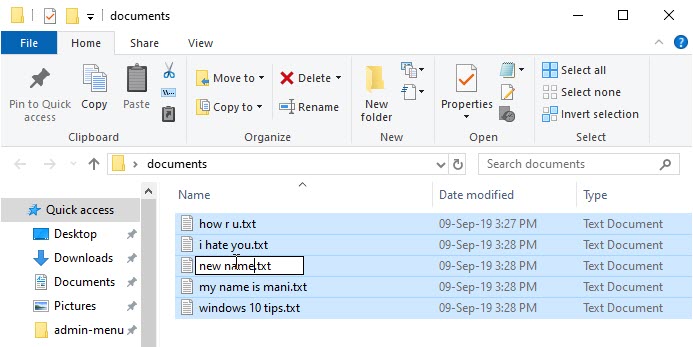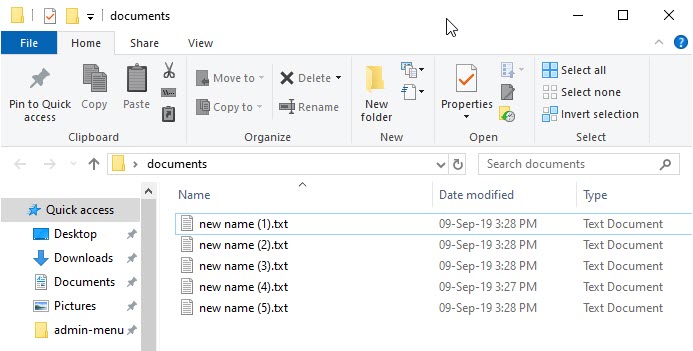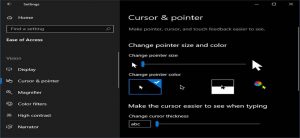In windows 10 you don’t need any third party software to rename your files. You can easily do the renaming of multiple files using File Explorer, Command Prompt and PowerShell on Windows 10. In this tutorial we will learn about batch renaming of multiple files on Windows 10.
How to batch rename multiple files using Windows 10 File Explorer:
This is the most easiest method of batch file renaming. Please follow below steps to rename multiple files using file explorer.
Open File Explorer in your Windows 10. To open the File Explorer in windows 10 1903, click the start button and select the File explorer. It will open the file explorer. Then locate the folder with the files to rename.
In the upper Home tab menu of the file explorer click the Select all button or press the Ctrl+A to select all files. Then click the Rename button from top menu. Or you can do it by right clicking on the selected files and then select Rename from the context menu. Then type the new file name and press Enter. This useful if your files in the same folder don’t need completely different names from one another.
You can undo the changes using Ctrl+Z key from keyboard.
If you want to rename one by one and each with different names, then only select the first file and click the Rename button and give the new name. You can jump to the next file using the Tab key from your keyboard.
How to batch rename multiple files using Windows 10 Command Prompt:
You can also change the name of the multiple files using Command prompt on Windows 10. First you need to open the Command Prompt via windows search. Then open the file location on Command prompt.
Here my files are saved in documents folder and the folder is saved on my Desktop. Then use this command to locate that folder
cd Desktop\documents
Then rename using “ren” command. Please follow below syntax to rename a single file.
ren "OLD-FILE-NAME.FILE-EXTENSION" "NEW-FILENAME.FILE-EXTENSION"
Example: if you want to rename a signle file “i love you.txt” to “love.txt” then
ren "i love you.txt" "love.txt"
Rename multiple files in bulk use below syntax.
ren *.FILE-EXTENSION ???-FILE-NAME.*
Example: Rename all files with “.txt” extension to “???-mani.txt.
Here the first three characters that is ??? are works as a unique identifier to avoid duplication.
ren *.txt ???-mani.*
Some other useful commands are
Rename or Change file extension:
ren *.OLD-EXTENSION *.NEW-EXTENSION
Example: change .txt file extension to .doc file extension.
ren *.txt *.doc
Rename part of the file names
Example: rename files start with “mani” to “kandan”.
ren mani*.* kandan*.*
How to batch rename multiple files using Windows 10 PowerShell:
You can also change the name of the multiple files using PowerShell on Windows 10. First you need to open the PowerShell via windows search.
Then open the file location on PowerShell. Here my files are saved in documents folder and the folder is saved on my Desktop. Then use this command to locate that folder
cd Desktop\documents
Then Please follow below syntax to rename a single file.
rename-item "OLD_FILE_NAME.EXTENSION" "NEW_FILE_NAME.EXTENSION"
Example: rename file “mani.txt” to “kandan.txt”.
rename-item "mani.txt" "kandan.txt"
If you want to renaming multiple files in bulk, then use the below syntax.
Dir | %{Rename-Item $_ -NewName ("NEW_FILE_NAME{0}.FILE_EXTENSION" -f $nr++)}
Example: Renames files with a “.txt” extension using the “mani_new_file” naming scheme and adds a different number at the end of the file name.
Dir | %{Rename-Item $_ -NewName ("mani_new_file{0}.txt" -f $nr++)}
if you want to change the file extension, then follow the below syntax.
Dir | Rename-Item -NewName { [io.path]::ChangeExtension($_.name, "NEW_FILE_EXTENSION") }
Example: Here it changes any file extension to “.txt”:
Dir | Rename-Item -NewName { [io.path]::ChangeExtension($_.name, "txt") }
Watch In Video:













